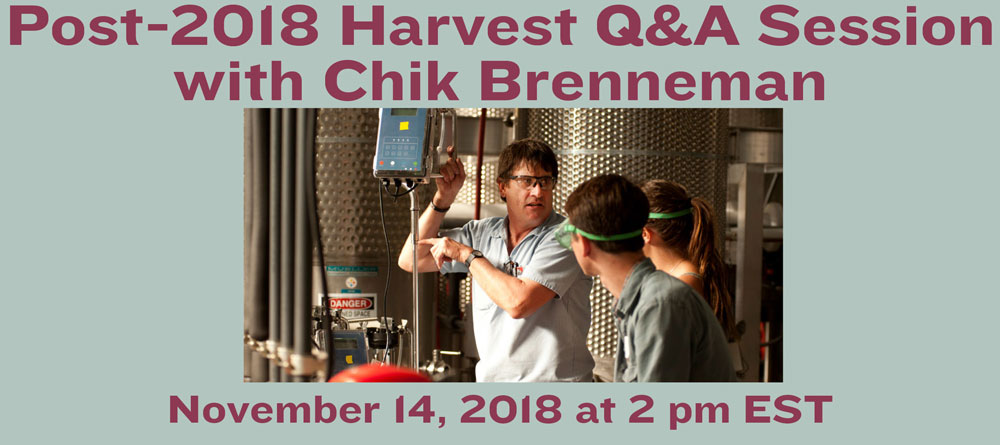Thanks everyone for turning out and a very special thank you to Chik for once again offering his expertise up to the hobby winemaking crowd. Thanks Chik!
Chat with Chik Brenneman from November 14, 2018
(11/14/2018)

| los |
12:49 |
Thursday November 8, 2018 12:49 |
2:04 |
Wednesday November 14, 2018 2:04 jeff |
|
2:05 |
Wednesday November 14, 2018 2:05 Bob Joakimson |
2:05 |
Wednesday November 14, 2018 2:05 Lori |
|
2:07 |
Wednesday November 14, 2018 2:07 Chris |
Chik Brenneman |
2:11 |
Wednesday November 14, 2018 2:11 Keir |
Chik Brenneman |
2:12 |
Wednesday November 14, 2018 2:12 Come Lague |
Chik Brenneman |
2:12 |
Wednesday November 14, 2018 2:12 David |
2:12 |
Wednesday November 14, 2018 2:12 Are we on yet? |
Chik Brenneman |
2:15 |
Wednesday November 14, 2018 2:15 |
2:16 |
Wednesday November 14, 2018 2:16 Dwight |
Chik Brenneman |
2:17 |
Wednesday November 14, 2018 2:17 David Boice |
Chik Brenneman |
2:19 |
Wednesday November 14, 2018 2:19 Doug Flowers |
Chik Brenneman |
2:20 |
Wednesday November 14, 2018 2:20 Tim |
|
2:21 |
Wednesday November 14, 2018 2:21 Meta |
Chik Brenneman |
2:24 |
Wednesday November 14, 2018 2:24 BkStigler |
Chik Brenneman |
2:26 |
Wednesday November 14, 2018 2:26 Marshall |
Chik Brenneman |
2:28 |
Wednesday November 14, 2018 2:28 Martin |
Chik Brenneman |
2:33 |
Wednesday November 14, 2018 2:33 BkStigler |
Chik Brenneman |
2:35 |
Wednesday November 14, 2018 2:35 I dont have a way to measure free SO2 at home – I have several wines bulk aging from thsi years harvest – added an amoun that in theory should have my reds around 50 PPM (post MLF) and my whites/rose at about 80PPM (to prevent MLF). what is a genenral gu |
Chik Brenneman |
2:38 |
Wednesday November 14, 2018 2:38 jeff |
Chik Brenneman
|
2:41 |
Wednesday November 14, 2018 2:41 Chris |
Chik Brenneman |
2:42 |
Wednesday November 14, 2018 2:42 David Boice |
Chik Brenneman |
2:48 |
Wednesday November 14, 2018 2:48 Bob Joakimson |
Chik Brenneman |
2:50 |
Wednesday November 14, 2018 2:50 Lori |
Chik Brenneman |
2:51 |
Wednesday November 14, 2018 2:51 BkStigler |
|
2:51 |
Wednesday November 14, 2018 2:51 Martin |
Chik Brenneman |
2:55 |
Wednesday November 14, 2018 2:55 Gibbs Yadkin Valley |
Chik Brenneman |
2:58 |
Wednesday November 14, 2018 2:58 Cathy |
Chik Brenneman |
2:58 |
Wednesday November 14, 2018 2:58 |
3:00 |
Wednesday November 14, 2018 3:00 BkStigler |
3:00 |
Wednesday November 14, 2018 3:00 Meta |
3:01 |
Wednesday November 14, 2018 3:01 Ewa |
3:02 |
Wednesday November 14, 2018 3:02 Lori |







